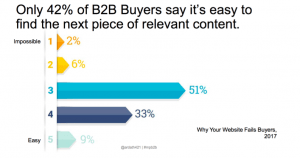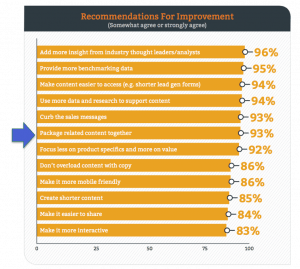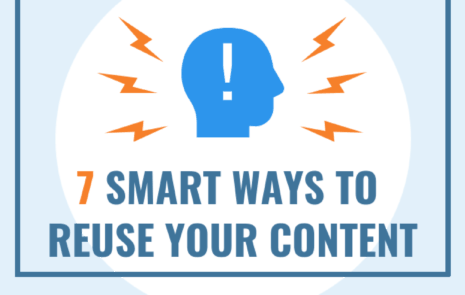
Top 100 Content Marketing Question: What is the best way to better engage readers?
The best way to better engage readers is gradually.
Let readers set the pace. Don’t dump too much information (TMI) on them all at once.
1. Offer a content snack, then scale up
To better engage readers, start them out with a taste – a content snack. Then let them gradually build up to a full-course meal of content, at their own pace.
When you create a Message Map with a concise, clear, consistent, and scalable message, you’re always ready to serve up relevant and resonant content of any size. Here’s how.

To start out, hook your audience by grabbing their attention in the first 7 seconds. Here’s why you need to hook your audience that fast.
Your 7-second hook can be a headline, email subject line, elevator speech, or social media post. It answers your reader’s question, “What’s in it for me?” (WII-FM?)
With a Message Map, you gracefully scale up your content serving sizes, as you see in the chart below:
• From 7 seconds to 2 minutes
• From 2 minutes to 5 minutes
• From 5 minutes to 20 minutes.

After each piece of content that your reader consumes, offer another on the same topic. By doing so, you make it easy for readers to know what to do next.
Build an easy path for readers to follow through your content, to speed the buyer’s journey from interest to purchase. That’s how you better engage readers – by keeping them moving forward.
This approach sounds simple, but most websites fail to do it. A study called “Why Your Website Fails Buyers” shows that only 42% of B2B buyers say it’s easy to find the next relevant piece of content. Ouch!

As you organize content on your website, but like with like. The vast majority of buyers want related content neatly packaged together.
In fact, 93% of buyers ask that related content be packaged together, says the DemandGen B2B Content Preferences Survey.

Once you intrigue a reader, offer various short-form content – videos, blogs, web pages, or infographics — as 2 minutes, 400-word pieces of content.
Where to get ideas about what to say in 2 minutes? From your Message Map.
As you engage readers, build up to 5-minute, 1,000-word content. Finally, offer readers long-form, 20-minute, 4,000-word content.
That’s the way to better engage readers – laddering up at the reader’s pace from short-form to long-form content. On carefully considered purchases, long-form content often outperforms short-form content.

2. Strong opinions, original research, and other people’s content breakthrough
Andy Crestodina, the author of Content Chemistry, notes that strong opinions and thought-provoking content better engage readers.
For example, the President can shape a whole 24-hour news cycle with one opinionated Tweet.
Is it possible to communicate strong opinions without offending some readers? Here’s a blog about the pros and cons of content built on strong opinions.
Perform original research. Make original observations, first-hand. Or hire an industry analyst to take a 3- to the 5-year view of coming industry trends that will affect customers.
Aggregate other people’s research, then adds value to it by making it easier to read, more visual, and easier to understand.
If you field surveys, share the results of surveys publicly. Unexpected findings or a unique point of view can transform a survey result into the news.
Invite others to generate content for you. For example:
• Interview experts to quote your content.
• Invite people to write a guest blog.
• Stimulate user-generated and employee-generated content.
A LinkedIn study found that your company’s employees reach an audience 10 times bigger than your company can.
Why not court employees as brand ambassadors, and prompt them to share content you routinely provide? Here are specifics on how to harness user-generated and employee-generated content.
3. Change the stimulus frequently
People have lazy brains. Human brains get habituated easily, which means readers get bored fast.
How to overcome reader boredom?
Cognitive neuroscientist Dr. Carmen Simon advises: changing the stimulus, at least every 20 minutes, to hold readers’ interest. For example, change from:
• Text to graphics
• Formal to informal
• Static to dynamic
• Monologue to dialogue
• Facts to stories
• Complexity to simplicity.
Or vice versa. Here’s a graphic and blog on how to keep audiences engaged by overcoming habituation.

4. Make small asks before the big ask
If you get overly anxious about converting a reader into a buyer, you may scare them off. Instead, build a relationship through content, so the reader becomes a buyer at his or her own pace.
Too many websites pounce on readers too fast, pushing them to buy the product before any relationship exists. That’s like proposing marriage on the first date – completely off-putting.
Instead, first, ask for a soft conversion.
For example, invite people to read another piece of content, watch a video, or take a survey or quiz. It gives you a proverbial foot in the door for your content.
When a reader says yes to a soft conversion, he or she is far likelier to say yes to a bigger ask later on. That’s due to the principle of human consistency.
It’s wise to track both types of conversions – soft and hard. Why? Because when readers answer yes to a small ask, the human consistency principle urges them to say yes to your even bigger ask.
Make a small ask (a soft conversion) before the big ask (such as a hard conversion that puts buyers into the demand pipeline).
Track soft conversions, and you’ll find that they predict future hard conversions.
5. Progress from content to conversation to conversion
At first, encourage readers to engage with your text, graphics, and videos. To raise the level of engagement, ask readers to take a survey or a simple quiz on your topic.
That’s how you pivot the conversation from being all about you to being all about them. Invite people to participate by:
• Gauging their knowledge
• Comparing themselves to benchmarks
• Taking a test such as this fascinating personality test from marketer and author Sally Hogshead.
After a test, people always want to know how the results came out. They’ll anxiously await what you have to say about their results.
Not only will your readers learn more about themselves from a test, but also you’ll learn much more about what makes them tick.
After a reader says yes to more content, a quiz, or a test, it’s time to nudge them towards the demand funnel:
• Suggest they attend a webinar.
• Invite them to a trade show or customer event.
• Offer them exclusive information if they sit down with your salesperson.
Use content to build relationships with readers:
1. Offer a content snack, then scale up.
2. Breakthrough with strong opinions, original research, and other people’s content.
3. Change the stimulus frequently.
4. Make small asks before the big ask.
5. Progress from content to conversation to conversion.
To learn more about the best way to engage readers, watch my Content Marketing World video: How to Speed the Journey from Content to Cash.

“What is the best way to better engage readers?” is one of marketers’ Top 100 Questions about content marketing. Here are answers to marketers’ Top 100 Questions.
Related Posts
84 Questions to Spark Your Business Story
To ignite your story, start with the right questions When I work with clients to co-create their business story, we start with questions about customers...
Win Buyers’ Attention with the Right Size Message
When you share your business’ story, at first a buyer may give you only a few seconds of attention. As in the story of Goldilocks...
Why You Need to Keep Marketing Messages Simple
What your marketing messages can gain from 3 usability ideas Recently I read a great little e-book on usability called The Ten Commandments of UI Design....
Top 100 Content Marketing Question: How can I leverage existing content in my content marketing strategy?
How can I leverage existing content in my content marketing strategy? When you already have good content, do you always need to create more?...





